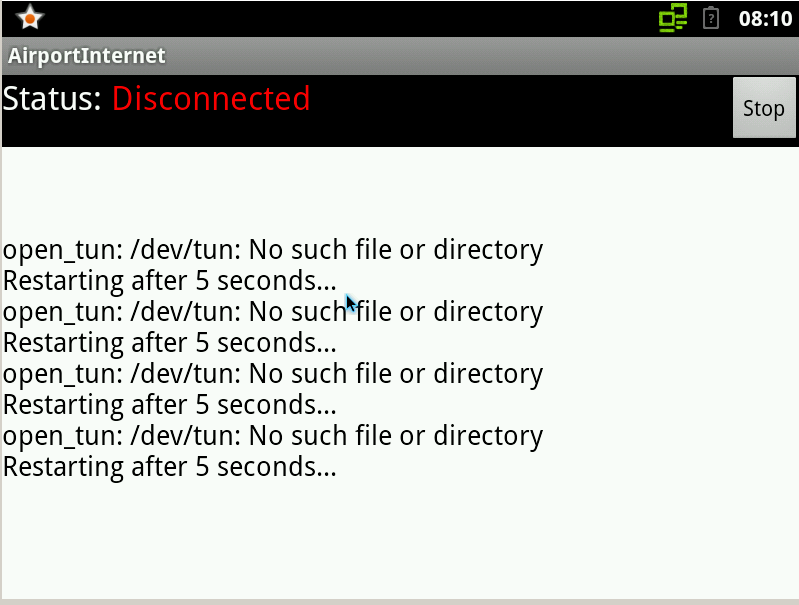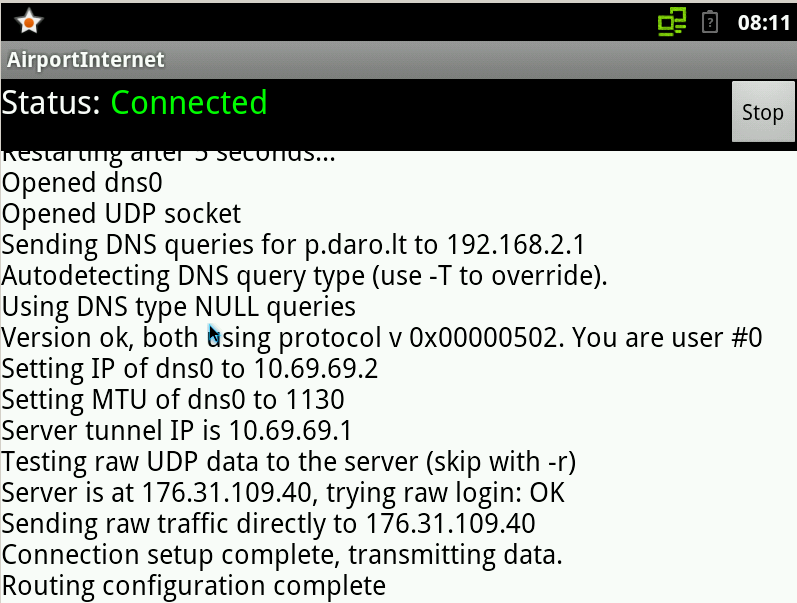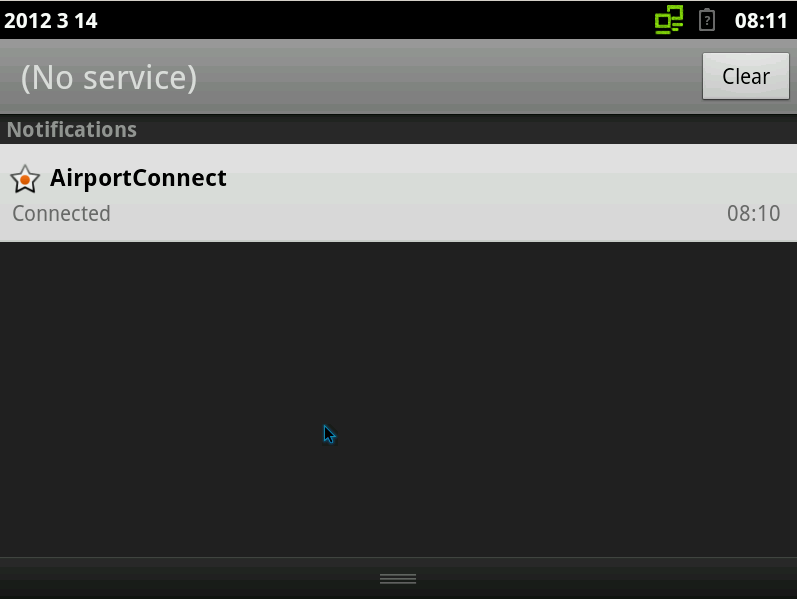This project is obsolete and is unlikely to build/work on recent androids (4+ is not tested). Please see MagicTunnel instead:
http://www.magictunnel.net/download.php
I did not try it myself, but got a recommendation from a person which was fed up trying to build AirportInternet and notified me.
This is an iodine front-end for Android. Iodine lets you tunnel IPv4 data through a DNS server. This can be usable in different situations where internet access is firewalled, but DNS queries are allowed. Hence the name -- AirportInternet -- because in fact most "partially free" hotspots are in the airports.
Primary goal was to aggressively achieve stability and fault recovery. That means if connection is closed by iodine or service is closed by Android, AirportConnect attempts to recover and re-connect without user intervention.
Several configuration profiles are supported. User can set up different profiles for different servers.
When connection is established, a service goes to background and is re-openable using an Android notification. Connection status is seen real-time in the notification.
Route configuration is auto-magical. When connected, iodine starts the configuration script which configures traffic to go through iodine server. When iodine socket is closed, routes are automatically released by kernel.*
- tun.ko (available from "tun.ko installer")
- rooted phone (due to tun.ko and routing configuration)
- slightly patched iodine (necessary if you want to see console-like output). Iodine binary should be setuid-root, installation instructions below
routing.sh(from this repository)
AirportConnect expects both iodine and routing.sh to be in
/data/data/org.airportinternet/. If paths are different, please adjust
constants in header of ForkConnection.java.
Connector.java is the glue between the UI and iodine logic. It has these
abstract methods:
start(Setting setting)(to start the connection)stop(to stop the connection)
And these callbacks:
sendLog(String)(to send logging output from connector to the application)connecting()(notification that connection was initiated)connected()(notification that connection was successful)disconnected()(notification that connection was dropped)
Connector.java hides the complexity of managing UI states, notifications,
settings and makes it easy to write connector backends. ForkConnector.java is
the most straight-forward implementation that could possibly work. Like name
suggests, it forks-execs iodine C program with necessary parameters.
Having Connector, it will be relatively easy to add NativeConnector, which
would exploit Android.net.VpnService and communicate with the native Android
4 tun pseudo-device.
Current implementation is not intended to be for end-users due to too many pre-requirements (rooted phone, tun.ko and setuid bit are only for developers to ask). Due to upcoming better implementation, these probably will not be changed (for example, we could work around the necessity of setuid bit, however, it is better to put more effort to native implementation instead).
For routing script invocation program uses su. I already noticed that su
invocations in android-x86 and in Nexus One differ dramatically. In android-x86
a shell script routing.sh with one parameter 127.16.0.0 must be executed
like this:
$ su -c sh routing.sh 172.16.0.0
However, Nexus One expects everything that is after -c to be one argument:
$ su -c "sh routing.sh 172.16.0.0"
This makes it necessary to implement various work-arounds and runtime checks of
su command. For now, I settled with Android-x86 version. However, users are
encouraged to find out the way it is done in their architecture and modify the
source accordingly.
This wasn't unexpected; shell script invocation from languages like C of Java
always been difficult. With native Connector implementation calling the shell
scripts will be just unnecessary.
-
Build project:
android update project; ant release. -
Build iodine for android.
cd iodine; make cross-android-dist -
Install generated
AirportConnect.apk -
Copy files to the phone:
$ adb push iodine/bin/armeabi/iodine /data/data/org.airportconnect/ $ adb push routing.sh /data/data/org.airportconnect/ $ adb shell # mount -o remount,suid /data # depending on phone, might be not necessary # chmod 4777 /data/data/org.airportconnect/iodine
Enjoy!
* In some cases a static route to dns server via gateway might remain after closing iodine. In 99.9% of the cases it doesn't change anything, since packets to DNS server go through default gateway anyway.
As mentioned earlier, original iodine had to be patched. Here is the
motivation.
Warn, warnx, err, errx are BSD extensions to standard library which print
logging messages to standard error. They do not exist in Android, so had to be
re-implemented from scratch. In iodine implementation it used variadic
arguments (va_start_, va_list, etc). However, using these functions for
strings garbled the output. For that reason I reimplemented the functions above
using macros directly to fprintf and exit commands.
\newpage



